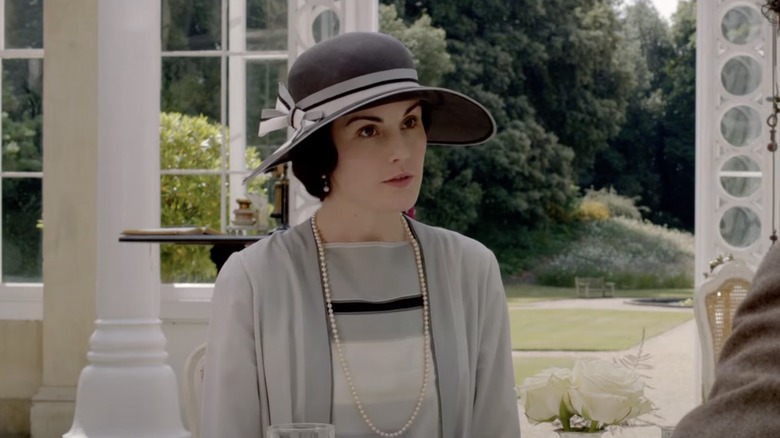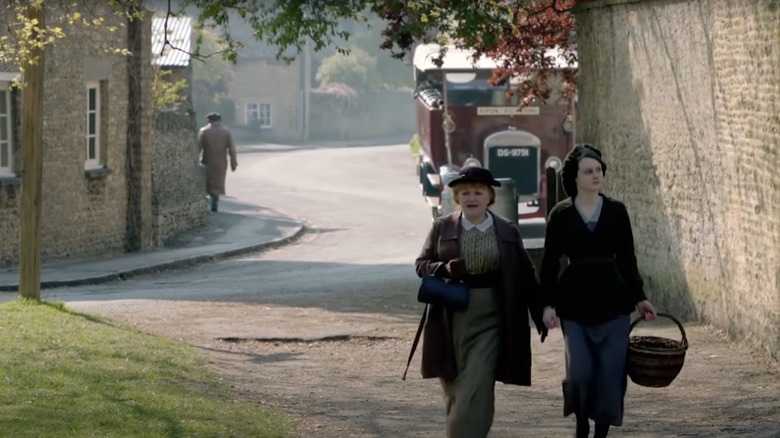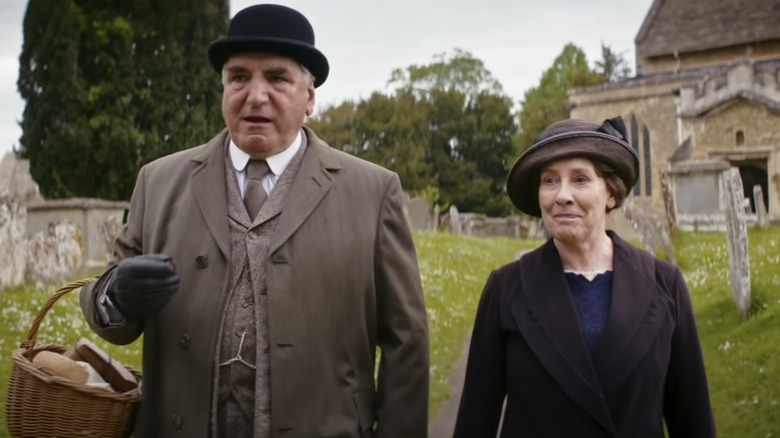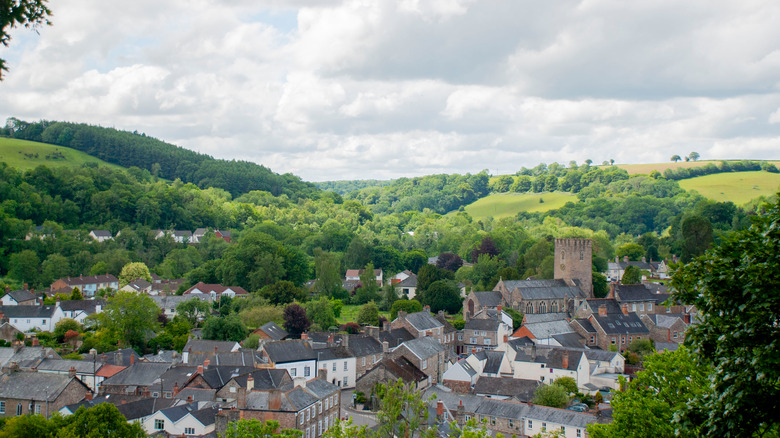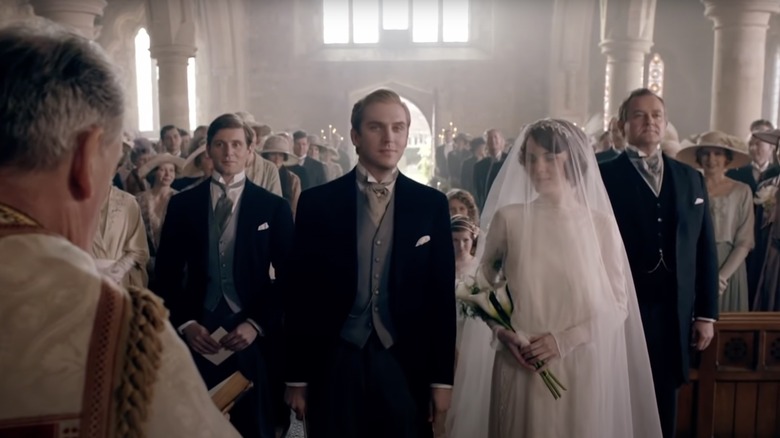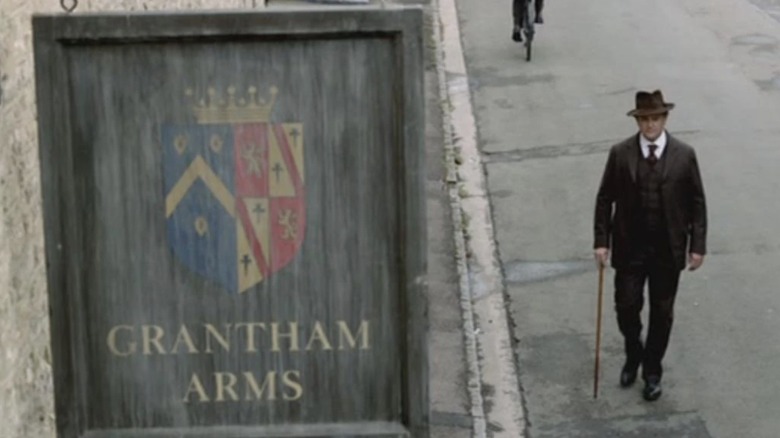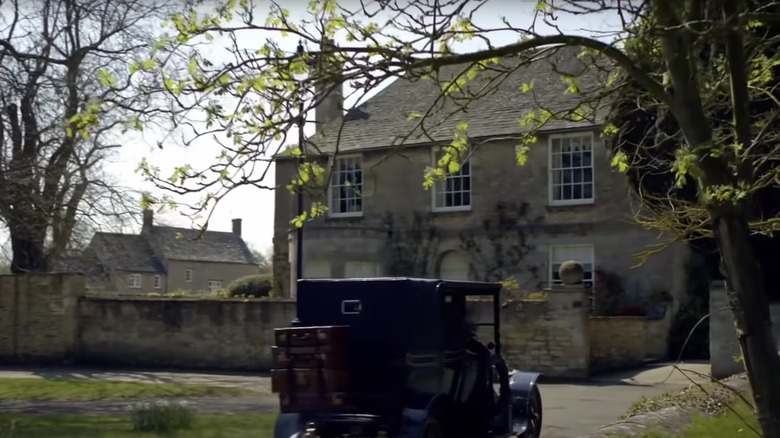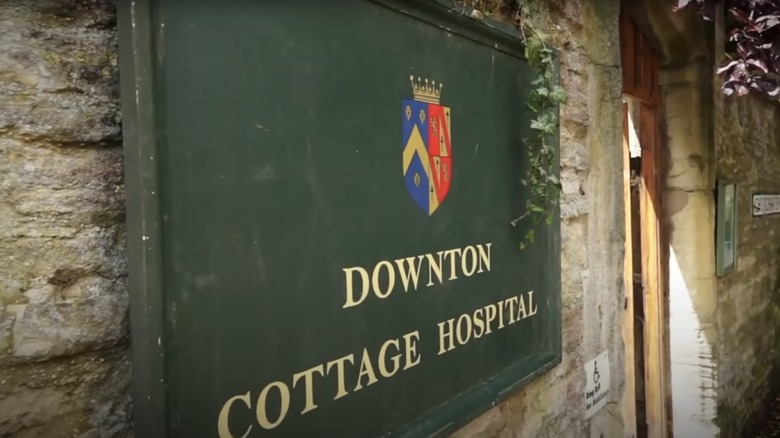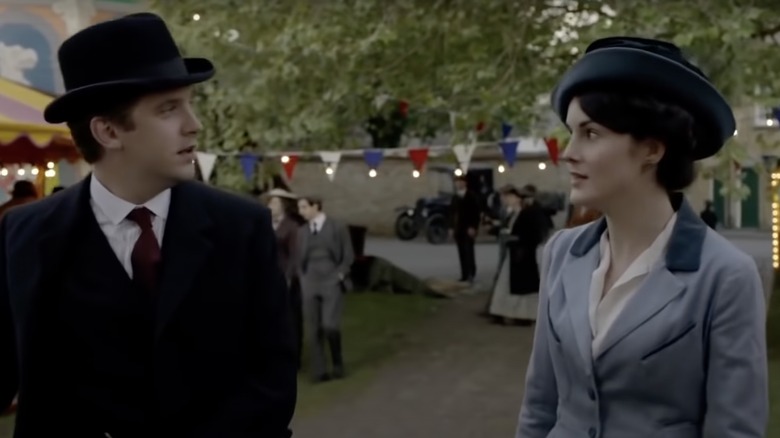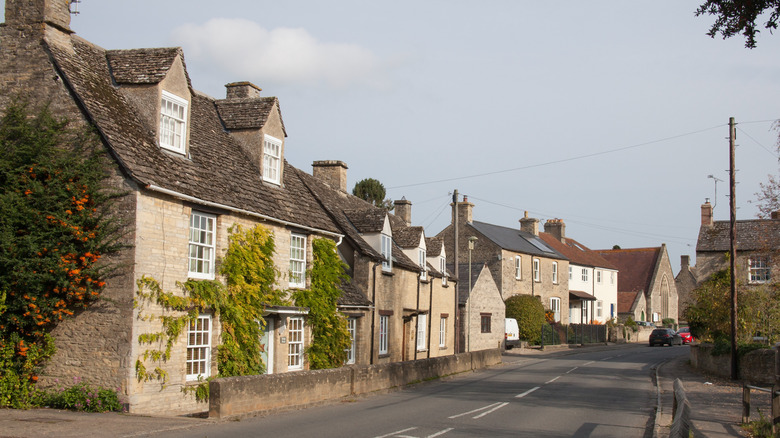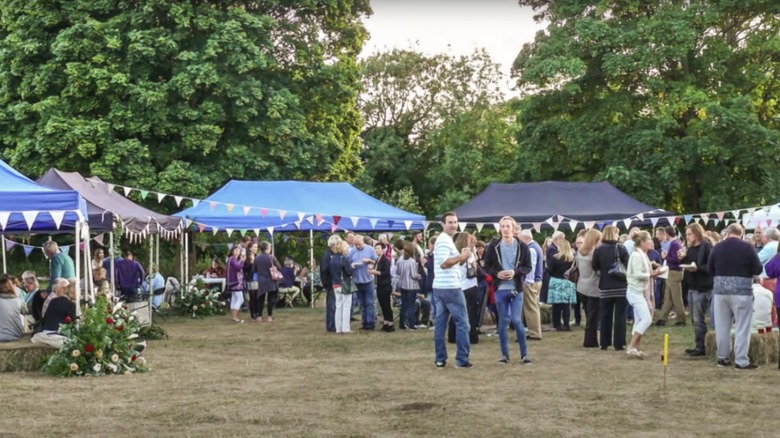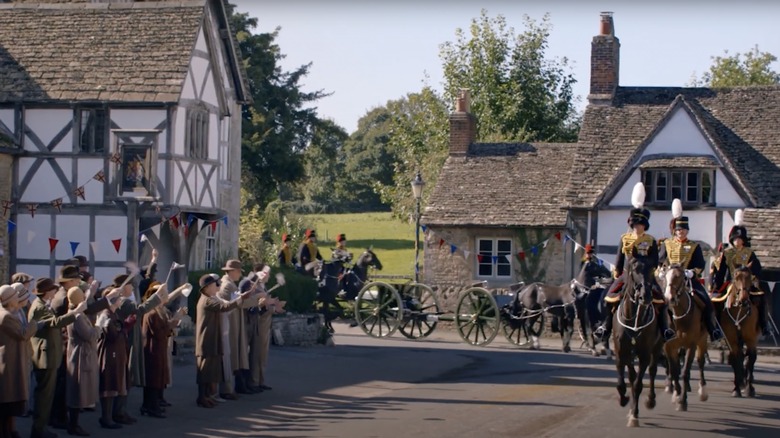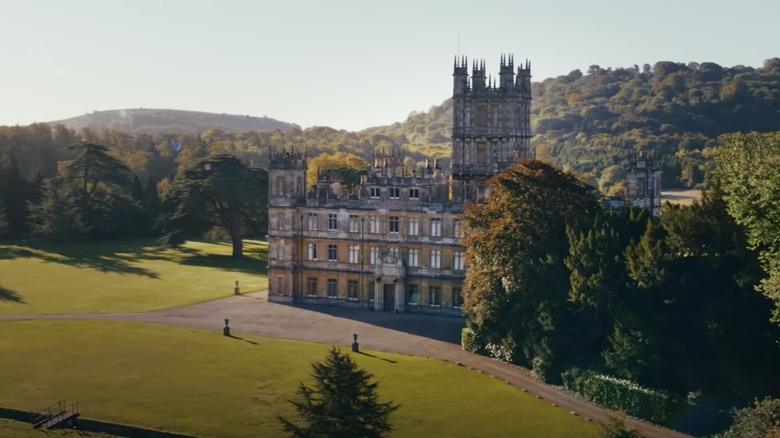Inside The Real Village Downton Abbey Is Filmed In
When "Downton Abbey" first aired on ITV and PBS in 2010, no one expected it to become a smash hit, but after six seasons, it was the top PBS drama of all time. Set in the early 20th century, the show followed the Crawley family and their army of servants. Looking back, it's easy to see why the show was such a hit. It had everything viewers could want — will-they-won't-they relationships, shocking scandals, plenty of intrigue, and, of course, completely gorgeous costumes. It also boasted some stunning historic locations in England. The abbey itself was actually the famous Highclere Castle in Hampshire. You may also remember plenty of scenes that took place in the local village of Downton.
Sadly, Downton isn't a real place — but there is a real-life village that comes pretty close. The village scenes were actually shot in the picturesque village of Bampton. Curious to find out more about the location that became home to the cast and crew of "Downton Abbey" for 10 whole years? Here is everything you need to know about Bampton.
A lot of Downton Abbey was filmed in Bampton
Bampton is a tiny village in West Oxfordshire. In 2009, it was selected as the perfect filming location for the fictional Yorkshire village of Downton in "Downton Abbey." Several houses and spots in the village became frequent filming locations for the series. Everything from the roads to the village green were used in the show. There were even a few buildings that became central sets, such as Isobel Crawley's house, the church, the pub, the post office, and the hospital — although many of these sets were created inside buildings that had quite different purposes in real life.
As Oxfordshire Live reported, even though Bampton provided most of the sets for the village, it wasn't the only filming location for village scenes. Nevertheless, the cast and crew spent plenty of time in the village, and any "Downton" fan would instantly recognize many of the locations in Bampton if they were ever to visit.
Bampton is a very, very old town
In "Downton Abbey," the village of Downton is a quaint, ancient town in the north of England. In real life, the village of Bampton is pretty similar, although it is actually in Oxfordshire, which exists much further south in England than where the fictional Downton was supposed to be.
As the Parish Council of Bampton notes, Bampton is actually one of England's oldest towns, dating back to the Iron Age. Prior to that, the town may have even existed during Roman times. Naturally, it has changed a lot over the years, and much of it was built between 1650-1750. During that time, Bampton became well-known for selling leather, and more and more middle class people settled there. By the 19th century, it had grown, boasting over 20 shops. In the 20th century, when "Downton Abbey" is set, the town probably looked a lot like it does on the show. It had an active community and several annual fairs. Apparently, many of the old village customs still exist to this day.
How the team picked Bampton as their filming location
It's clear that the town of Bampton has all the history that the production team of "Downton Abbey" needed for the town of Downton, but why was that particular location chosen? There are plenty of other British towns that had the right look and could have easily passed for an early 20th century village.
In a documentary for the BBC, the show's creator, Julian Fellowes, explained, "I seem to remember I was simply shown photographs [of Bampton] and it seemed perfect." Apparently, it actually took the production team a while to find their perfect locale. According to the Witney Gazette, Dame Pippa Harris, a resident of Bampton, was friends with Donal Harris, the show's production designer, and she recommended the village. "Within a week he was here with his team, and it looked as though he'd found the perfect place," Bampton local Robin Shuckburgh explained on his YouTube channel, "The Cotswold Explorer." The town, he explained, had wonderful historic features, was close to Highclere Castle, and had plenty of parking space for the film crew.
Bampton's church appears in numerous weddings and funerals
Plenty of scenes in "Downton Abbey" take place at the local church — Mary's wedding, Edith's wedding, Matthew's funeral, baby christenings, and so on. The beautiful historic church of Downton was actually the Church of Saint Mary the Virgin Bampton. As Robin Shuckburgh explained in a video on his YouTube channel, "The Cotswold Explorer," the church was a key filming location. "The church was the only building we used for filming indoors," he said. "In Bampton, every other bit of filming was done just on the external parts of the buildings, but in this case, they used the inside as well." Shuckburgh also pointed out that the road just behind the church was used as a parking location for all of the film crew's vans.
Funnily enough, the church has become so recognizable as a "Downton Abbey" filming location that many fans of the show forget that it's just that — a fictional location. "Many a local in this village has been asked in all seriousness by visiting tourists where they can find Matthew Crawley's gravestone," he said. "Now that really is a bit weird."
One cottage served as a pub in Downton Abbey
Remember the local pub in the village of Downton? There were a few key pub scenes in the show, often between Anna and Mr. Bates. It turns out, the exterior of the pub in Bampton wasn't actually a real pub — in fact, it was just a cottage that they transformed for the show. "This little cottage behind me was The Grantham Arms in 'Downton,'" Robin Shuckburgh pointed out on his YouTube channel, "The Cotswold Explorer." "It's a nice little cottage, it's privately owned of course now." Shuckburgh went on to explain that the cottage went up in value because of the show. "It's changed hands several times in the last few years, which gives you some indication as to what happens when a major television series is filmed in your village," he said.
In fact, the cottage was even featured in a 2016 article in Express when it was put up for sale. The article explained that the cottage was transformed into a pub with painting on the door and outdoor beer barrels. Apparently, the owners of the cottage kept the original Grantham Arms sign that was used in the first series.
Churchgate House was the Crawley House – and the actors' green room
In the very first episode of "Downton Abbey," we see Isobel and Matthew Crawley move into their new home in Downton. The filming for the exterior shots of the house was done at Churchgate House in Bampton, a private family home. As Robin Shuckburgh explained on his YouTube channel, "The Cotswold Explorer," "The lady who owns the house was wandering around in her garden the other day and she came across a complete stranger who was having a look." Apparently, when the owner of the house asked if she could help, the stranger replied, "Do you live here? ... Did you buy the house from the Crawley family?" Sounds like some fans can't quite wrap their heads around the fact that "Downton Abbey" is fiction! In another video, Shuckburgh noted that the house also served as the actors' green room, a place where they could rest between takes.
In a documentary for the BBC, actor Hugh Bonneville spoke to the owners, Rod and Maggie Harris. Apparently, they've lived in the house since 1991, when they bought and completely renovated it. Of course, the interiors of the Crawley House were actually shot somewhere else, so most fans will never get to see inside.
An old grammar school became the hospital
Another prominent location in "Downton Abbey" was the hospital where Dr. Clarkson worked. In reality, the building is an old grammar school in Bampton. In a documentary on "The Cotswold Explorer," Robin Shuckburgh's YouTube channel, he explained that the grammar school has been restored over the past few years thanks to a fundraising campaign started by actor Hugh Bonneville, which allowed them to completely restore the roof. "Once [the restorations are] finished, it will be a permanent exhibition of the filming of 'Downton' in Bampton, along with other exhibitions and events," Shuckburgh said.
In an interview between Shuckburgh and Bonneville, the pair discussed the importance of the building to Bampton. "It was built in the 17th century by a man called Robert Vesey," Shuckburgh said. Apparently, Vesey was actually "something of a rogue." Nevertheless, the residents of the town still love the building and also use it for their library and their archives.
A village green also appears in several outdoor scenes
The buildings of Bampton weren't the only parts of the town that were featured on "Downton Abbey." The village green, Sanford Field, was also used for some of the outdoor fairs and events in the town. You may remember Lord Grantham considered building more houses on the field. Apparently, the bridge he crossed on his way to the field was constructed just for the show!
On "The Cotswold Explorer," Robin Shuckburgh's YouTube channel, he explained, "This is Sanford Field, a very important part of our lives in Bampton where all the outside events are held. The latest was the Donkey Derby, which was just a couple of weekends ago. The weather shone and the children rode the donkeys." Sounds like something pulled straight out of a "Downton Abbey" episode if you ask us!
The village even has a Downton Abbey tour
Because there are so many recognizable "Downton Abbey" locations in Bampton, the town now has its own "Downton Abbey" tour for fans who visit the filming location. The tour's headquarters are located in the Bampton Library (where the hospital was filmed). "The film has regenerated interest and more people than ever are coming to the town," a local volunteer told the Witney Gazette.
And by the sound of things, the tour's popularity has only grown throughout the years. "The tourist numbers have grown — even now they're growing even though the series finished quite a long time ago," Robin Shuckburgh said in a documentary with Hugh Bonneville for "The Cotswold Explorer," Shuckburgh's YouTube channel. "The projects are that we will go on having, you know, tens of thousands of visitors every year ... we had 27,000 I think it was that came through this shop this year." It sounds like "Downton" is still just as popular as ever.
The cast had a party with the villagers at the end of the show
One of the most remarkable things about "Downton Abbey's" time in Bampton is just how well the cast and crew got along with the local villagers. "They were so understanding and nice and they sort of looked after us," Julian Fellowes told the BBC.
In fact, the cast and crew were so appreciative of the Bampton locals, they even said thank you with a big barbecue when the sixth season wrapped. "On our final visit of the main TV show we had a fantastic barbecue ... that was a nice farewell," actor Hugh Bonneville said in an interview with local Robin Shuckburgh. "It was an absolutely wonderful evening and, yeah, being served burgers and wine by you guys was enormous fun," Shuckburgh replied. Clearly, the cast and the villagers became good friends after 10 years of filming!
Another village appeared in the Downton Abbey film
While Bampton did provide most of the exterior village shots in "Downton Abbey," it wasn't the only village featured in the series. Lacock, a village in Wiltshire, appeared in the film. As Somerset Live reported, Lacock is a tiny village that is owned by the United Kingdom's National Trust because of its many ancient buildings. This makes it perfect for British shows — "Harry Potter," "Wolf Hall," "Pride and Prejudice," and "The Other Boleyn Girl" all shot scenes in Lacock, too.
As the National Trust wrote, Lacock appeared in the "Downton Abbey" film during the parade scene. Producer Gareth Neame explained that the parade scene needed to be a grand affair: "The parade scene featured 350 extras including real-life Lacock villagers in period-accurate costumes and 80 soldiers on horseback, plus a royal carriage." Apparently, Lacock was better suited than Bampton for this scene. "Lacock plays its role beautifully as a part of the village of Downton which somehow we have never seen before," Julian Fellowes said.
The castle that became Downton Abbey is nearby
Of course, the other famous "Downton Abbey" location is the abbey itself. In real life, the house is called Highclere Castle. The castle is only an hour's drive from Bampton, where the local village scenes were filmed.
The castle is still home to the 5th Earl of Carnarvon and his family, but the house is opened up to the public for some of the year. As the Radio Times noted, the house looks a lot like it does on the show, and you can see plenty of familiar scenes both inside and outside. If you're an avid TV and film fan, you might even recognize the castle from its other appearances in things like "Eyes Wide Shut," "Jeeves and Wooster," "Robin Hood: Prince of Thieves," and "The Secret Garden." And with Bampton just an hour away, you can see all of the famous "Downton" spots in just one day.
